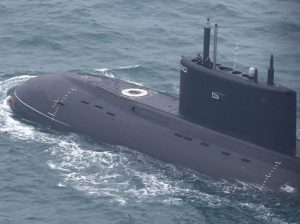Wittman: We Need An Atlantic Rebalance
Posted on

Rep. Rob Wittman
The Chief of Naval Operations (CNO) John Richardson made a major organizational announcement with major strategic implications when he announced the Navy would re-establish the Second Fleet, which covers the Atlantic.
But that would, so far, only mean adding 250 people to the command. Without making larger strategic changes, that is not enough.
To respond appropriately to Russian naval aggression and support the re-establishment of Second Fleet, we must revisit our plan for homeporting ships and consider moving critical assets closer to the Atlantic. Simply adding people to Second Fleet to oversee the same 60/40 strategy will result in little tangible impact. More submarines and submarine-hunting surface ship platforms should make their way east to be ready to patrol the Atlantic.
Richardson, speaking while aboard the USS George H.W. Bush (CN 77) in Norfolk, Virginia, said the Second Fleet would be “a dynamic response to the dynamic security environment.” Clearly, Russia’s recent naval buildup and provocations in the North Atlantic were significant contributing factors to this. But even with this renewed focus on Russia, we remain stuck with an outdated 60/40 force posture that deprioritizes the Atlantic Ocean. That needs to change.
Very simply, under the current 60/40 naval force posture, 60 percent of naval forces are homeported in the Pacific, while only 40 percent are homeported in the Atlantic. This plan was introduced by then-Secretary of Defense Leon Panetta in June 2012 – just nine months after disestablishing Second Fleet – while speaking at the Shangri-La Dialogue in Singapore.
This 60/40 plan was part of the Obama administration’s economic and foreign policy-focused rebalance to the Pacific after a draw-down of U.S. military presence in the Middle East. Since the plan’s announcement six years ago, this nation has had three Secretary of Defenses, ushered in the Trump administration, and shifted defense priorities in the recently released National Defense Strategy. Yet somehow, amidst all these significant changes, we continue to follow a 60/40 plan despite its misalignment with our current 2018 threat environment.
Since Panetta’s 2012 speech, Russia has upgraded its Navy, particularly its submarine fleet, and employed it in provocative North Atlantic operations. Just a few months ago, our NATO partners expressed concern about increased Russian submarine activity near critical undersea data cables. These cables provide intercontinental Internet capability and, if damaged or purposefully destroyed, could cause serious infrastructural problems.
 In my April op-ed, I described how Russia’s increased submarine emphasis should motivate our own submarine build-up. For further context on my assertion, Russia plans to add six modernized Project 636.3 (Kilo) nuclear attack submarines to its naval inventory by 2021. In addition, Russia is aggressively modernizing its aging Oscar-class nuclear attack submarine tasked with missions such as attacking our nation’s surface ships and other priority land and sea targets.
In my April op-ed, I described how Russia’s increased submarine emphasis should motivate our own submarine build-up. For further context on my assertion, Russia plans to add six modernized Project 636.3 (Kilo) nuclear attack submarines to its naval inventory by 2021. In addition, Russia is aggressively modernizing its aging Oscar-class nuclear attack submarine tasked with missions such as attacking our nation’s surface ships and other priority land and sea targets.
Clearly aware of this threat, CNO Richardson told Congress in March that Russia’s renewed focus on undersea warfare was, “exactly why our investments [in European operations] are focused on the anti-submarine warfare problem, both enhancing our undersea sensors and then … infrastructure for the antisubmarine aircraft, the P-8.” While the Navy clearly recognizes Russian undersea investment and increasingly hostile naval posture, I believe further action needs to be taken.
In a letter to Navy Secretary Richard Spencer in March, I outlined several other benefits to East Coast homeporting such as cost savings and shorter transit times to critical theaters. With all of these factors in mind, I look forward to reviewing the Navy’s updated Strategic Laydown to see how the Russian threat and Second Fleet’s establishment will affect the Navy’s plans. There’s a popular saying in the military that “quantity is a quality all its own.” Let’s give Russia a clearer view of American industrial and naval might by bringing our ships closer to their home.
Congressman Rob Wittman represents the 1st District of Virginia. He is chairman of the House Armed Services seapower and projection forces subcommittee and the House Natural Resources Committee.
Subscribe to our newsletter
Promotions, new products and sales. Directly to your inbox.
